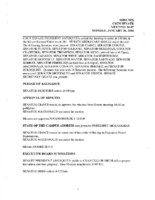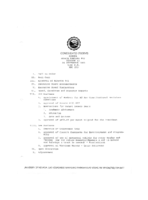Search the Special Collections and Archives Portal
Search Results
Documentation
Level of Description
Archival Collection
Collection Name: History of Nursing in Southern Nevada Oral History Project Records
Box/Folder: N/A
Archival Component
Nursing paper research by Margaret Kendall, 1995, undated
Level of Description
Archival Collection
Collection Name: History of Nursing in Southern Nevada Oral History Project Records
Box/Folder: Box SH-041 (Restrictions apply), Box 01 (Restrictions apply)
Archival Component
III. Morelli House public programs, 2005-2016
Level of Description
Scope and Contents
The Morelli House public programming series is comprised of records detailing the Junior League of Las Vegas' public access and interpretative programming operations for the Morelli House as a community cultural center. Programming operations, funding, and publications records are included in this series.
Archival Collection
Collection Name: Junior League of Las Vegas' Records on the Morelli House Preservation Project
Box/Folder: N/A
Archival Component
#68518: A behind the scenes look at "Carmen" production during its final dress rehearsal in the Artemus Ham Hall March 15, 2012 at the University of Nevada, Las Vegas, 2012 March 15
Level of Description
Archival Collection
Collection Name: University of Nevada, Las Vegas Creative Services Records (2010s)
Box/Folder: Digital File 00
Archival Component
George, John, and Joseph Foley oral history interview, 2002 July 05
Level of Description
Archival Collection
Collection Name: Voices from the Past: the Las Vegas Springs Preserve Oral History Project Interviews
Box/Folder: Digital File 00, Box 01
Archival Component
Gladys Neville oral history interview (OH-02775), 2004 June 02
Level of Description
Archival Collection
Collection Name: History of Nursing in Southern Nevada Oral History Project Records
Box/Folder: Box 01 (Restrictions apply), Digital File 00
Archival Component
Gerardo Topacio, Philomena Topacio, and Teresa Prezgay oral history interview
Identifier
Abstract
Oral history interview with Gerardo Topacio, Philomena Topacio, and Teresa Prezgay conducted by Claytee D. White on April 13, 2018 for the Boyer Early Las Vegas Oral History Project. In this interview, Gerardo discusses his early life in Manila, Philippines. He remembers the attacks in Pearl Harbor on December 07, 1941, the Japanese and Philippines conflict, and immigrating to the United States. Gerardo talks about his employment with Edgerton, Germeshausen, and Grier, Inc. (EG&G) and working at the Nevada Test Site. Philomena recalls her career in the hotel industry and being a member of the Culinary Workers Union Local 226. The couple was joined by their daughter, Teresa Prezgay. Prezgay talks about her career as a math teacher and promotes the increase of women in science, technology, engineering and mathematics (STEM) fields.
Archival Collection

Meeting minutes for Consolidated Student Senate, University of Nevada, Las Vegas, January 26, 2004
Date
Archival Collection
Description
Text

Meeting minutes for Consolidated Student Senate, University of Nevada, Las Vegas, September 06, 1983
Date
Archival Collection
Description
Text

